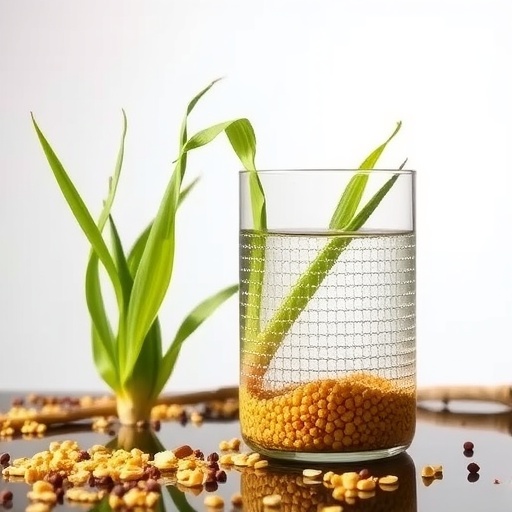In a groundbreaking study published in Environmental Monitoring and Assessment, researchers have explored the potential of agricultural waste—specifically maize stems—as a bio adsorbent for the removal of manganese from contaminated water. With the increasing concern for environmental pollution and water quality, this innovative approach not only addresses the urgent issue of heavy metal contamination but also focuses on sustainability and the efficient use of waste materials.
Manganese, a critical element necessary for various biological processes, transitions into a hazardous contaminant when consumed in excessive amounts. Its presence in drinking water can lead to neurological and developmental impairments, particularly in children. As industrial activities and agricultural runoff continue to pollute water bodies, the need for effective remediation strategies has never been more pressing. Traditional methods of water treatment often generate secondary pollution, thus propelling researchers to seek eco-friendly alternatives that are both effective and sustainable.
The study emphasizes the dual benefit of using maize stems, a typically discarded agricultural byproduct. By converting agricultural waste into a resource, the researchers not only mitigate the pressing issue of water contamination but also promote circular economy principles. The team utilized various analytical techniques to process the maize stems into bio adsorbents, optimizing conditions to enhance manganese adsorption capacities.
The process began with the collection of maize stems, which were then subjected to carbonization, a thermal treatment method that significantly modifies their physical and chemical properties. Carbonization not only increases surface area but also enhances porosity, creating a favorable environment for heavy metal ion adsorption. The transformed maize stem bio adsorbent exhibited remarkable efficiency in trapping manganese ions from solutions, showcasing its potential as an effective alternative for conventional adsorbents.
Subsequent experiments analyzed the efficacy of these maize-stem bio adsorbents at varying concentrations of manganese. The results were promising; the bio adsorbents demonstrated high adsorption rates under optimized conditions, highlighting their potential for real-world water remediation applications. Furthermore, the study delves into the kinetics of adsorption, portraying the interaction dynamics between manganese ions and the porous structure of the maize-based material.
In addition to efficiency, the researchers also assessed the regeneration capabilities of the bio adsorbents after manganese removal. Regeneration is crucial for the sustainability of any adsorbent material; it minimizes waste and enhances economic viability. The maize stem adsorbents could be effectively regenerated through simple chemical treatments, suggesting a reusable option for water treatment facilities facing heavy metal pollution.
This research presents an innovative solution that aligns with global sustainability goals. With the world grappling with water scarcity and pollution, harnessing agricultural residues for biosorption not only preserves the environment but also supports economic activities in rural areas, where maize is cultivated predominantly. The authors assert that the agricultural community stands to benefit significantly from adopting such techniques, which could lead to new income-generating pathways while simultaneously addressing environmental challenges.
The implications of this study stretch far beyond academic curiosity. As nations strive to meet the Sustainable Development Goals (SDGs), particularly those focused on clean water and sanitation, the introduction of cost-effective, sustainable water treatment solutions becomes paramount. Implementing maize-derived bio adsorbents could facilitate the transition towards greener practices, fostering cooperative efforts between researchers, farmers, and policymakers.
Despite the promising results, the authors acknowledge that further research is necessary to fully understand the long-term effectiveness of maize as a biosorbent. Exploring various agricultural biomass sources could expand the toolkit available for water remediation. By integrating interdisciplinary approaches combining agriculture, environmental science, and engineering, future studies could unveil an array of sustainable solutions tailored to local contexts.
The study elucidates the pressing need for innovative approaches to water treatment, especially in rural regions where heavy metal contamination poses a significant threat to public health. The thorough examination of maize stems as a bio adsorbent raises crucial questions about resource management and preservation in the face of environmental degradation. Engaging local communities in sustainable practices represents a step towards empowering them to take charge of their water sources and public health.
In conclusion, this research not only presents a viable method for manganese removal but also advocates for the responsible use of agricultural waste. By highlighting the environmental and economic benefits of converting maize stems into bio adsorbents, the authors make a compelling case for broader adoption of such sustainable technologies. As the demand for clean water grows, innovative solutions like these offer hope for a healthier, more sustainable future.
Subject of Research: Water Remediation Using Maize Stem-Derived Bio Adsorbents
Article Title: Maize stem-derived bio adsorbent for manganese removal: from agricultural waste to water remediation
Article References:
Kassimu, Y.Y., Sharma, S.K., Sharma, S. et al. Maize stem-derived bio adsorbent for manganese removal: from agricultural waste to water remediation.
Environ Monit Assess 197, 1168 (2025). https://doi.org/10.1007/s10661-025-14633-y
Image Credits: AI Generated
DOI: 10.1007/s10661-025-14633-y
Keywords: Manganese removal, biosorption, maize stems, water remediation, agricultural waste




